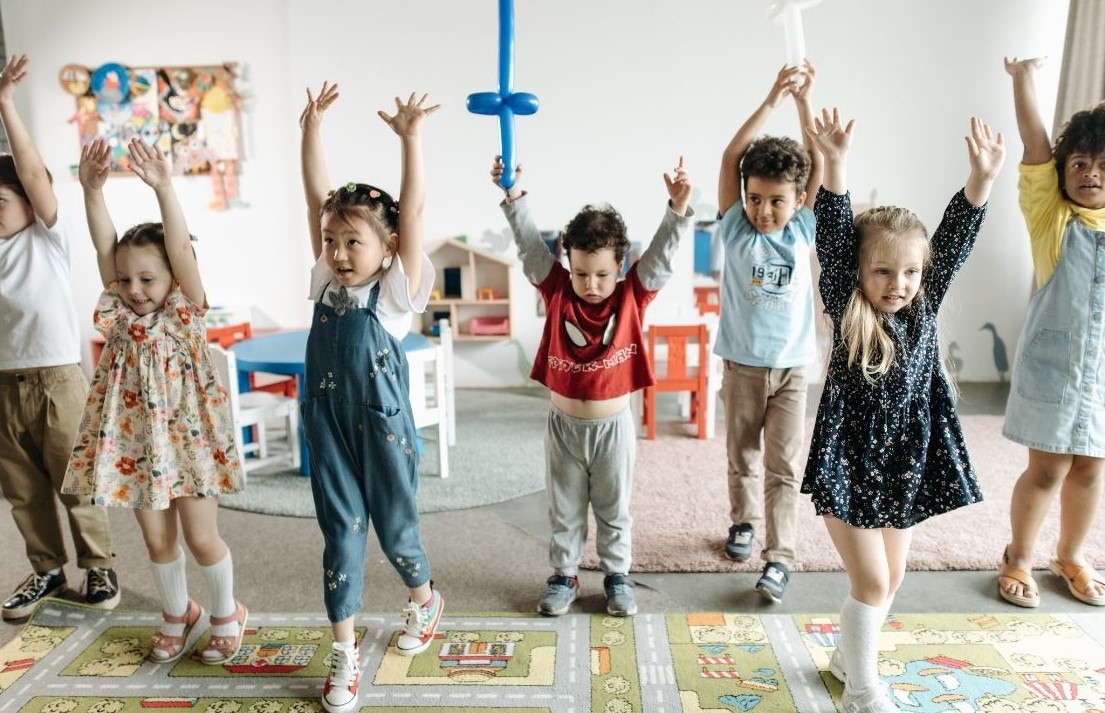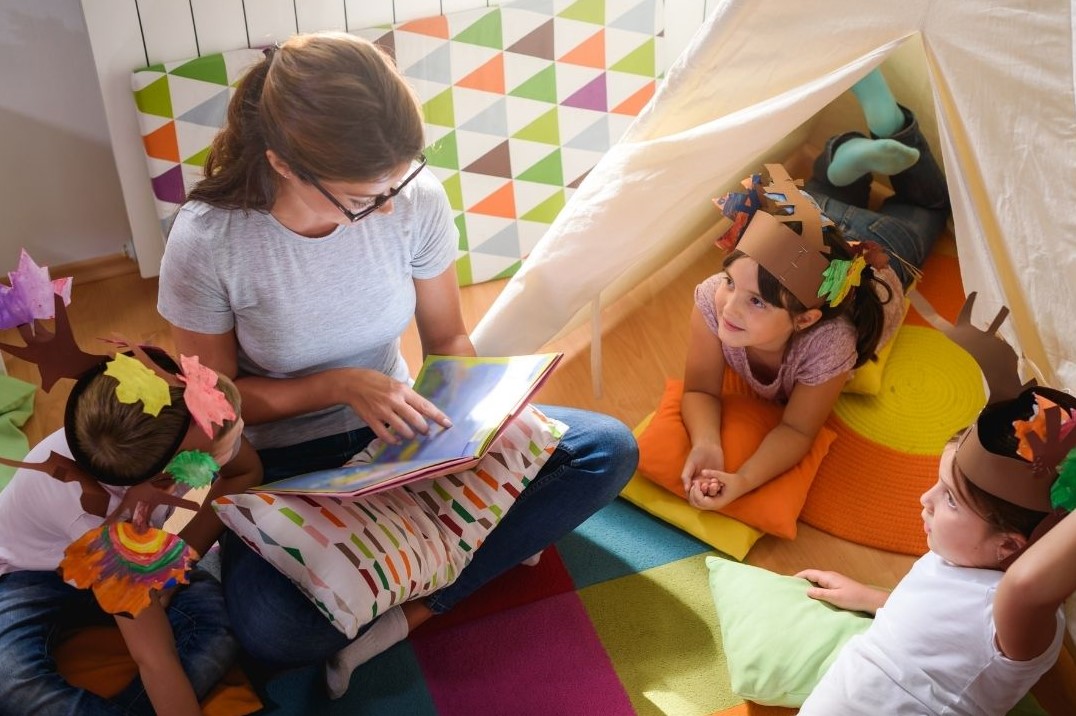Introduction to Drama Education
The theatre was once defined as an art and a prototype of human communication. It goes without saying that theatre constitutes a means of a show but also a means of self-expression.
Although we might not realize it, theatre and the act of dramatization are present amongst children from a very young age, for example, in role-play.
These dramatized games such as “the shops” or “Mums and Dads”, which they carry out represent admiration and the idea of looking up to people they idolize or their most exciting places.
Although simple, these role-playing games which attempt to recreate and reenact the adult world around them, allow children to subconsciously process society around them, therefore supporting the development of the child.
By playing theatre games, children practice body expression, develop social and emotional skills, and enrich their language and communication skills whilst simultaneously boosting creativity and imagination.
It is the teacher’s role to guide and encourage these types of drama and theatre activities because learning through drama is all about play, learning to express emotions, feeling, and actions to learn new things and material in a natural and unforced way within the classroom environment.
Utilizing Drama in the classroom can prove to be an invaluable asset in fostering child development.
Importance of Inclusive Practices in Drama Education

Inclusive practices in drama education are crucial for promoting diversity, equity, and inclusion in the classroom.
How drama can be a powerful tool for fostering inclusivity
Sharing Perspectives and Stories:
Drama allows students from different backgrounds to share their unique perspectives and stories. Through character development, improvisation, and storytelling, students explore diverse experiences, cultures, and identities. This promotes a deeper understanding and appreciation of individual differences and fosters an inclusive and accepting classroom environment.
Breaking Stereotypes and Challenging Bias:
Drama education provides a platform to challenge stereotypes and biases. Students can create performances that tackle social issues, challenge discriminatory attitudes, and promote social justice. By examining and addressing stereotypes through dramatic expression, students develop critical thinking skills and contribute to creating a more inclusive society.
Building Empathy and Understanding:
Inclusive drama activities allow students to step into the shoes of characters from different backgrounds, cultures, and identities. This experience cultivates empathy, enabling students to develop a greater understanding and respect for others. By engaging in collaborative and inclusive practices, drama education fosters a sense of belonging and empathy within the classroom.
Drama education in the classroom holds immense power to engage students, foster creativity, and promote holistic development.
Key aspects that highlight the power of drama education
Emotional Expression and Empathy:
Drama provides a safe space for students to explore and express a wide range of emotions. Through role-playing and character development, students develop empathy as they embody different perspectives and understand the motivations and experiences of others. This cultivates emotional intelligence and enhances interpersonal skills.
Communication and Collaboration:
Drama activities require effective communication and collaboration among students. By working together in improvisation exercises, script reading, or group performances, students learn to listen, express their ideas clearly, negotiate roles and ideas, and adapt to others’ contributions. These skills are crucial for effective teamwork and social interaction.
Creativity and Imagination:
Drama education stimulates students’ creativity and imagination. It encourages them to think outside the box, explore different possibilities, and take risks in their artistic expression. Through improvisation and storytelling, students develop their imaginative thinking and enhance their ability to generate original ideas.
Critical Thinking and Problem-Solving:
Drama activities promote critical thinking as students analyze characters, scripts, and situations. They learn to interpret text, make connections, and evaluate choices in their performances. Drama also presents students with problem-solving opportunities, as they navigate through various challenges in creating scenes, resolving conflicts, or adapting to unexpected situations.
Confidence and Self-expression:
Engaging in drama builds students’ self-confidence and self-esteem. As they perform in front of an audience or participate in group activities, they develop a sense of accomplishment and overcome stage fright. Drama education empowers students to express themselves authentically and find their own voice, boosting their overall self-assurance.
Language Development:
Drama education contributes to language development by improving verbal and nonverbal communication skills. Students practice articulation, intonation, and projection while delivering lines or expressing emotions. They also develop active listening skills, observation, and interpretation of body language, facial expressions, and gestures.
Personal and Social Awareness:
Engaging in drama fosters personal and social awareness. Students explore their own identities, values, and beliefs while also recognizing and respecting the identities of others. Drama provides a platform to discuss social issues, challenge stereotypes, and develop an understanding of diverse perspectives, promoting inclusivity and social responsibility.
Reflection and Self-evaluation:
Drama education encourages students to reflect on their own performances, evaluate their strengths and areas for improvement, and set goals for growth. This reflective practice enhances self-awareness, self-regulation, and a commitment to continuous learning.
Joy and Engagement:
Drama education creates a joyful and engaging learning environment. It taps into students’ natural inclination for play and storytelling, making learning enjoyable and memorable. This, in turn, enhances motivation, active participation, and overall student engagement in the classroom.
By harnessing the power of drama education, educators can create a dynamic and transformative learning experience that nurtures students’ creativity, emotional intelligence, critical thinking, and social skills, fostering their holistic development as individuals and active participants in society. Moreover, it is important to adapt each activity to the age of the group.
Engaging theatre activities for different age groups

There are various ways in which children may explore the theatre within the classroom to aid and support their development.
Engaging Theatre Activities for Different Age Groups To effectively integrate drama into the classroom, it’s important to tailor activities to the specific age group of students. Here are some engaging theatre activities for different age ranges:
For younger students in preschool and kindergarten, symbolic games are a great form of experimentation to encourage within this age group, this includes a range of spontaneous games with no purpose, in which the child substitutes real actions for imaginary ones and transforms the meaning of objects to experience certain “fictional situations”.
Preschool and Kindergarten (3-5 years old):
Symbolic Games: Encourage spontaneous games where children engage in imaginative play. These games involve substituting real actions for imaginary ones and transforming the meaning of objects to experience fictional situations.
Examples:
- “Mom and Dad”: Each child can have a specific role from the family members (mom, dad, sister, grand-father) and pretend to live together, this play is really appreciated by kids, they just must imitate their family and act like them, it’s helpful for the learning of vocabulary.
- “Tea Party at the Castle”: Children can set up a pretend castle with tables, chairs, and colorful fabrics. They can dress up as kings, queens, princes, and princesses and engage in a tea party with imaginary tea and treats. Encourage them to use polite language and practice table manners as they interact with each other.
- “Doctor”: Children can step into the shoes of doctors, nurses, and patients. They learn about medical tools, basic healthcare procedures, and the importance of taking care of their bodies. Create a doctor’s office or a hospital play area within the classroom. Use props such as a play stethoscope, bandages, doctor coats, medical charts, and a waiting area with chairs.
Throughout the course of time, these self-expressive drama games begin to evolve naturally, and you may find that your young students may begin to imitate, mirror, and art like those around them.
For elementary school children, educators may begin to introduce a form of theatre called “dramatization” or “dramatic play” in which the classroom invents and improvises different scenarios, characters, and themes to act out.
Elementary School (6-11 years old):

Dramatic Play: Introduce dramatization or dramatic play activities where students invent and improvise scenarios, characters, and themes. Provide open-ended prompts and allow children to create their own situations and stories. This helps them represent themselves and others, explore their creativity, and develop problem-solving skills.
Examples:
- “The Superheroes”: Design your own superhero characters with unique powers and create a scene where your superhero squad saves the day from a villain or a challenging situation.
- “The Mystery at School”: Create a scene where a group of young detectives solves a mysterious case that takes place in their own school. Invent clues, suspects, and unexpected twists.
- “The Lost Treasure”: Create a scene where a group of explorers embark on a treasure hunt to find a hidden treasure. Invent clues, obstacles, and exciting discoveries along the way.
The role of the teacher within this group work is to stimulate the game by being a character and allowing the action to progress, allowing the children to create their own situations and stories. This type of activity helps children identify and represent themselves and others, self-explore and flourish their creativity. This stage is called the pre-representation of the character.
For slightly older students, middle graders (12-14 years old), educators should introduce activities that are slightly more theatrical in which students generate short arguments, quickly prepared with a present conflict and improvised action and dialogue, to create a performance for their classmates.
Middle School (12-14 years old):
Scripted Scenes: Engage students in more theatrical activities by introducing scripted scenes. Divide them into groups and provide short scenes or scripts for them to rehearse and perform. Encourage students to interpret the characters, explore dialogue delivery, and express emotions. This activity helps develop teamwork, communication skills, and understanding of theatrical conventions.
Examples:
- “Alice in Wonderland”(adapted for the stage): This classic tale offers a wide range of colorful characters and whimsical scenes, making it ideal for middle school students. The play captures the imaginative world of Alice and her encounters with the Mad Hatter, Cheshire Cat, and Queen of Hearts. It allows students to explore imaginative settings, quirky dialogue, and the challenge of bringing beloved characters to life.
- “The Brothers Grimm stories”: This play takes the well-known fairy tales of the Brothers Grimm and combines them into a hilarious and fast-paced production. It offers numerous short scenes and opportunities for students to portray iconic characters like Cinderella, Snow White, and Rumpelstiltskin. It allows for creative interpretations and encourages students to explore comedic timing and physicality.
- “The Giver” by Lois Lowry (adapted for the stage): Based on the dystopian novel, this play explores a futuristic society where emotions and memories are suppressed. The story follows a young boy named Jonas who learns the truth about his seemingly perfect world. The play delves into themes of individuality, freedom, and the power of memory. It offers poignant scenes that allow students to explore complex emotions, character development, and thought-provoking ideas.
For high-school students, educators should introduce them to deeper and more complex plays, related to societal problems, for example, racism, or sexism: Students can imagine their own plays with bigger groups to interact with each other.
High School (15-18 years old):
Devised Performances: Foster creativity and critical thinking by guiding students in creating their own performances. Assign groups or allow students to form their own teams. Provide a theme or topic, and have them develop a performance using improvisation, scriptwriting, and collaborative decision-making. This activity encourages artistic expression, collaboration, and independent thinking.
Examples:
- Social Justice and Activism: Students can create a performance that addresses social justice issues, such as racial inequality, LGBTQ+ rights, climate change, or human rights. They can use theater as a platform to raise awareness, provoke discussions, and inspire action, shedding light on important social issues and advocating for change.
- Mental Health and Well-being: Students can explore the topic of mental health and well-being, highlighting the challenges young people face in today’s society. They can create a performance that addresses issues like anxiety, depression, peer pressure, or self-esteem, aiming to reduce stigma, promote empathy, and encourage dialogue about mental health.
- Technology and the Digital Age: Students can examine the impact of technology and the digital age on individuals and society. They can explore themes like social media addiction, online bullying, privacy concerns, or the blurred line between virtual and real-life experiences. The performance can provoke reflection on the benefits and challenges of living in a hyperconnected world.
The Role of the Teacher in Drama Education

As a teacher, being aware of the criteria and the best theatre activities for each age group, allows teachers to satisfy the needs of the students and allows each student to use their self-expression and creativity within the classroom.
Although the teacher does not play a particular character within the activities themselves, they play the crucial role of the animator, using the appropriate stimuli to initiate each activity, either with verbal suggestions or sensory stimulus, but always based on the theme that the group has decided to dramatize.
Within the older groups of children, the role of the teacher varies slightly. The educator will aid the students prior to the dramatization by providing stimuli such as photos, objects, newspaper headlines, etc.
Teachers will aid with the general organization of work and perhaps the most commonly used technique, making the class reflect and brainstorm by asking the following questions: Who? Where? When? Why? What?
Here, the intervention of the teacher during the preparation of the work becomes important to maintain the general rhythm of the class, establish the order of the presentations and encourage slow groups to conclude their projects. The educator acts as an organization, time management, and support tool for students in their independent group work.
Unveiling the Benefits of Drama in Education

Drama education provides a rich environment for fostering emotional intelligence in students. It is engaging in dramatic activities that help children understand and express their emotions, empathize with others, and develop self-awareness and emotional resilience.
Learning or studying through drama can have many advantages within education. Introducing theatrical activities within your classroom will support the development of your students in many beneficial ways:
- Enhances creativity: drama combines speech, experimentation, and improvisational skills which all contribute to the creative mind of students.
- Improves language skills and develops key skills of questioning, instructing, persuading, advising, and debating, which can be adapted to other subject material.
- Increases open-mindedness: using role play, students can explore realistic environments which discuss key issues that are tackled through dramatization. This can bring clear development in understanding and modifying future behaviors among students.
- Improves problem-solving skills: improvisational techniques will allow students to reflect on solutions and solve unexpected problems and issues.
- Encourages teamwork: working in a group is crucial in the development of children and therefore these activities strengthen these skills through advising, devising work, and communication.
- Develops communication skills: through the exploration of drama, talking and listening to others within groups will allow students to exchange ideas freely and effectively.
- Increases retention of information: the dialogue that accompanies the movement and action within the drama can be retained and understood easier thanks to the gestures that make minds associate words with action.
- Understanding and Expressing Emotions: Through role-playing and character exploration, students in drama education are encouraged to tap into a wide range of emotions. They learn to identify, understand, and express various emotions, both their own and those of their characters. This process allows students to develop a deeper understanding of emotions and how they impact human behavior.
- Empathy and Perspective-Taking: drama activities require students to step into the shoes of different characters, understanding their motivations, experiences, and emotions. This helps students develop empathy and the ability to see the world from different perspectives. They learn to appreciate and respect diverse viewpoints, enhancing their interpersonal skills and fostering a sense of compassion.
- Self-Awareness and Self-Reflection: drama education encourages students to reflect on their own thoughts, feelings, and behaviors. They gain insight into their strengths, weaknesses, and areas for growth as performers and individuals. This self-awareness enables them to make conscious choices about how they express themselves and interact with others, fostering personal growth and emotional resilience.
- Emotional Resilience and Regulation: engaging in drama activities requires students to navigate and cope with a range of emotions, both on and off the stage. They learn to manage performance anxiety, handle setbacks, and adapt to unexpected situations. This cultivates emotional resilience, the ability to bounce back from challenges, and the capacity to regulate emotions in a healthy and constructive manner.
It changes from the usual courses, students are more involved, and interested and force themselves to give their best, they learn and stimulate themselves by having fun.
Conclusion: the transformative power of Drama Education
Drama education is a vital aspect of a child’s development, promoting language skills, teaching conflict resolution, and engagement with various subjects. It fosters creativity, problem-solving, and teamwork from an early age. By exploring imaginative realms, students develop as individuals, peers, and active learners. Integrating drama in classrooms allows students to make choices, express emotions, and form connections with their schoolwork.
Key benefits include the development of emotional intelligence as students gain a deeper understanding of their own emotions and learn effective expression. They also develop empathy and perspective-taking skills by stepping into different characters’ shoes, fostering compassion and respect for diverse viewpoints. Drama education encourages self-awareness and reflection, empowering students to make conscious choices in their interactions. It cultivates emotional resilience, helping students navigate challenges and bounce back.
In conclusion, drama education engages students, fosters creativity, promotes inclusivity, and cultivates essential life skills. By harnessing its potential, educators create transformative learning experiences, nurturing students’ holistic development. Drama allows students to express emotions, empathize, think critically, and develop the confidence and resilience needed to overcome life’s challenges.


I have written my Masters thesis on a similar topic: drama in English language teaching. It’s titled Bridging Text ans Performance through Stylistics. It was developed and assessed at the University of Nottingham in 2009. I’m just disappointed it never got published.
the document is excellent